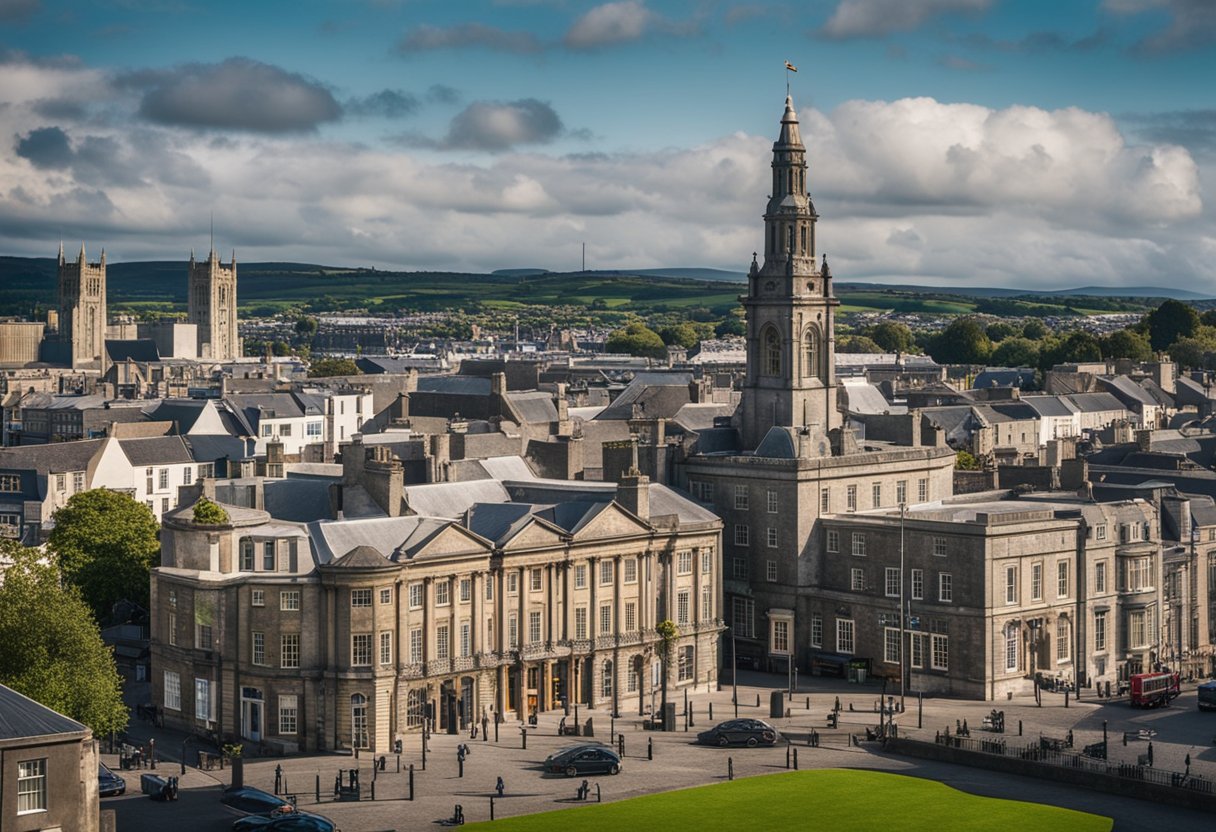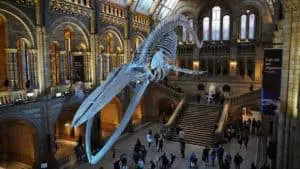The Celtic Tiger: Charting Ireland’s Remarkable Economic Surge and Societal Shifts!

Updated On: March 21, 2024 by Esraa Mahmoud
Ireland’s transformation into the “Celtic Tiger” represents unprecedented economic growth that reshaped its market dynamics and cultural identity. Between the mid-1990s and the late 2000s, Ireland achieved rapid economic expansion, which became synonymous with the roaring economies of East Asia. Celtic Tiger encapsulates Ireland’s journey from a historically agrarian economy to a modern, high-tech hub, attracting significant foreign direct investment and becoming an economic development model.
This period of prosperity was characterised by significant reforms in fiscal policies, an influx of global corporations seeking a skilled yet competitive labour force, and advancements within critical sectors such as information technology and pharmaceuticals. However, the narrative of the Celtic Tiger is not just about economic statistics; it also speaks to the social and cultural evolution that accompanied Ireland’s financial ascent. The economic boom brought about changes in Irish society, affecting urban development, lifestyle, and Ireland’s position on the global stage.
Historical Context
Before delving into Ireland’s economic transformation, it’s pivotal to understand how the country shifted from a protectionist stance to embracing economic openness and the profound impact of European Union membership.
From Protectionism to Economic Openness
In the early 20th century, Ireland’s economy was heavily characterised by protectionist policies that shielded domestic industries from external competitors. This approach was thought to promote self-sufficiency and reduce dependence on the UK. However, by the 1950s, it became apparent that protectionism stifled economic growth, and discussions on liberalising trade began. This shift towards economic openness was marked by progressive steps, including the Anglo-Irish Free Trade Agreement in 1965, which gradually eliminated tariffs and trade barriers with the UK.
Economic liberalisation continued, and by the late 1980s, Ireland had started to lower corporate taxes, attracting foreign direct investment, particularly from technology and pharmaceutical companies. These advancements laid the groundwork for the Celtic Tiger period, heralding unprecedented economic growth.
European Union and EU Membership Impact
Ireland joined the European Economic Community (EEC), now known as the European Union (EU), in 1973. This pivotal moment set the stage for profound economic and social reforms. As a member of the EEC and later the EU, Ireland benefited from access to a single European market, which allowed for the free movement of goods, services, capital, and labour.
EU membership also meant that Ireland received substantial EU structural and cohesion funds, which were instrumental in modernising the country’s infrastructure and enhancing competitiveness. The impact of EU funding coupled with an increasingly well-educated workforce, transformed Ireland from a peripheral European economy into one of the fastest-growing economies in the world during the Celtic Tiger years.
Economic Surge of the Celtic Tiger
In this section, we explore the crucial phases that marked the rapid expansion of Ireland’s economy, aptly nicknamed the Celtic Tiger and the pivotal role that foreign direct investment played in this extraordinary era of growth.
Phases of Growth
Two distinct phases of growth characterised the Celtic Tiger period. From the mid-1990s, Ireland witnessed an unprecedented surge in its gross domestic product (GDP), attracting admiration and analysis worldwide. This initial phase was powered by a combination of sound fiscal policies, substantial improvement in labour productivity, and a weak Irish Pound relative to the British Pound and other currencies, which provided a competitive edge for exports.
Following a brief slowdown, the second phase, often associated with The Boom, began around 2002 and lasted until 2007. During this period, our economy expanded again at a remarkable rate, with the construction industry and property markets playing significant roles. Growth rates during these years often exceeded 7%, which elevated Ireland to one of the fastest-growing economies in the world for that time.
Role of Foreign Direct Investment
Foreign direct investment (FDI) has been the cornerstone of Ireland’s economic success story. Attracting multinational corporations was a deliberate strategy fostered by our low corporate tax rates and a well-educated, English-speaking workforce. Our country became a preferred European base for numerous high-tech industries, including pharmaceuticals, chemicals, and information technology, which injected vitality into our economy. This surge in investor confidence was not just about financial metrics; it was a vote of confidence in the Irish workforce and the country’s potential as a hub for innovation and business excellence.
By capitalising on these strategic advantages, Ireland secured a steady flow of FDI that was instrumental in creating high-value jobs and driving the growth of our GDP during the Celtic Tiger years. This influx of capital and expertise from abroad transformed our economic landscape and instigated a significant cultural and social change as Ireland positioned itself more prominently on the global stage.
Key Sectors Driving Growth
The collective force behind Ireland’s impressive economic expansion during the Celtic Tiger era was rooted in key high-performing sectors. These industries attracted substantial foreign investment and significantly contributed to the nation’s exponential export growth.
Technology and Pharmaceuticals
We witnessed a remarkable influx of leading global tech corporations establishing their European bases on Irish soil. Favourable corporate tax rates and a skilled workforce largely drove this. Companies like Intel, Dell, and Microsoft were integral to this boom, with their operations contributing heavily to the technology sector’s growth. The pharmaceutical industry, similarly, experienced vast growth, with exports in this sector reaching new heights due to the presence of major multinational companies.
Tourism and Hospitality
Enriched by Ireland’s cultural appeal and natural beauty, tourism experienced a surge, becoming an essential part of our economy. The Emerald Isle’s hospitality sector bolstered growth and job creation by drawing globetrotters and cultural enthusiasts. The rise in visitors supported local businesses and reinforced the country’s reputation as a welcoming destination.
Agriculture and Food Exports
Our agriculture and food sectors have long been cornerstones of the Irish economy, with a significant contribution from food exports. Known for our verdant pastures and high-quality dairy and meat products, we’ve witnessed a consistent rise in demand for Irish foodstuffs, thus propelling the agriculture industry forward. Foreign investment and support from EU policies played a pivotal role in maintaining this sector’s robustness and global reach.
Financial and Legal Framework

Our discussion of Ireland’s economic rise, often called the “Celtic Tiger” period, includes a focused examination of the financial and legal frameworks that played pivotal roles. We’ll explore how strategic taxation policies and establishing a specialised financial district contributed to Ireland’s transformation.
Taxation Policies and Incentives
Ireland’s government implemented compelling tax incentives to attract foreign direct investment, positioning itself as a competitive location for business operations. The corporate tax rate was set at an appealing 12.5%, one of the lowest within the European Union, which acted as a significant draw for multinational corporations. These favourable tax rates underpinned the financial architecture that spurred economic growth.
Tax relief measures and fiscal policies were designed to encourage entrepreneurship and innovation. Such policies were integral in fostering a business environment ripe for domestic and international investors. Our financial management strategies ensured these incentives achieved the desired objectives, benefiting the state and the businesses.
International Financial Services Centre
In Dublin, establishing the International Financial Services Centre (IFSC) marked a turning point in our banking and finance sector. Launched in 1987, the IFSC became a hub for global financial services, encompassing banking, finance, insurance, and asset management firms. This precinct’s concentration of economic activities significantly enhanced Ireland’s reputation as a leading international financial centre.
Our country provided a supportive ecosystem for these financial institutions through strategic fiscal policy. The IFSC operates within a regulated framework ensuring transparency and adherence to international standards, which reassures investors and firms of the robustness of our financial systems. The legal framework surrounding the IFSC allowed for innovative financial services to flourish on Irish soil, contributing substantially to our economic prosperity.
Social and Cultural Impact

The emergence of the Celtic Tiger brought sweeping changes to Ireland’s social fabric and cultural landscape. We witnessed significant growth in education and skill levels, shifts in emigration patterns and living standards, and the evolution of social partnerships and the welfare state.
Education and Human Capital
Under the Celtic Tiger, Ireland’s investment in education played a crucial role in developing our human capital. The well-educated workforce attracted foreign direct investment and supported the high-tech industries that drove economic expansion. A young and well-educated population contributed to a vibrant, innovative culture, both a product and a fuel of Ireland’s economic boom.
Emigration and Living Standards
Traditionally, emigration was a default for many Irish citizens facing limited prospects at home. However, during the Celtic Tiger years, we saw a reversal with the return of expatriates and an influx of immigrants, enhancing cultural transformation and diversity. This period also marked an unprecedented improvement in living standards, with increased disposable incomes and greater access to consumer goods, although these benefits were not equally distributed.
Social Partnership and Welfare State
The era was characterised by a robust social partnership between the government, businesses, and labour, which played a significant part in Ireland’s economic success. The welfare state adapted to the buoyant economy, expanding its provisions. While these changes offered vast improvements in welfare and support systems, the sustainability of such growth became a concern, underscored by the economic downturn that followed.
Economy and Labour Market Dynamics
In this section, we will closely examine the profound changes within the Irish labour market during the Celtic Tiger period, focusing mainly on employment patterns, unemployment rates, wages, and competitiveness.
Employment Trends and Unemployment Rate
The Celtic Tiger era witnessed remarkable shifts in employment trends as Ireland transformed into a hub of high-tech industries. Employment rates surged, particularly in sectors like IT and finance, driven by an influx of foreign direct investment. The unemployment rate reflected this boom, dropping to historically low levels by 2000. However, the trend reversed dramatically with the economic crisis of 2008, leading to significant job losses and a spike in unemployment rates, reiterating the volatility of Ireland’s labour market.
Wages and Competitiveness
Ireland’s economic expansion brought about an upward trajectory in wages across multiple sectors, increasing living standards for many. Nevertheless, the rise in wages also sparked discussions about Ireland’s competitiveness on the global stage. Concerns were raised over the sustainability of such wage growth and whether it could undermine the low-wage competitive advantage initially attracting multinational corporations. This balancing act between maintaining competitive wage levels and ensuring a high standard of living for workers remained an ongoing challenge for Ireland’s economy.
Public Finances and Fiscal Policies
Before diving into the specifics of Ireland’s financial and fiscal landscape during the Celtic Tiger period, we should recognise the role of astute budgetary policies and the management of public finances. These created a favourable economic environment that spurred growth and development.
Government Debt and Expenditure
Government debt and expenditure are critical in shaping a nation’s fiscal health. During the Celtic Tiger years, Ireland’s approach to tackling government debt centred on strict budgetary measures to reduce the debt-to-GDP ratio. These measures included strategies that focused on controlling public spending rather than increasing taxation, which proved to be a successful course for a small, open economy like Ireland’s. The moderation in public expenditure was accompanied by substantial interest rate reduction, bolstering fiscal stability and making Ireland an attractive location for investment.
Subsidies and EU Financial Support
Significant subsidies and financial support from the European Union further bolstered investment in Ireland during the rapid economic expansion. The influx of EU subsidies provided a critical financial cushion that allowed Ireland to invest in its infrastructure and human capital. This period saw substantial investments in education and industry, aiding the transition to a more knowledge-based economy. The availability of EU funds, alongside the government’s initiative to incentivise specific industries, laid the groundwork for sustainable economic growth and development.
The Property Bubble and its Aftermath
In the late 1990s and early 2000s, Ireland experienced a remarkable economic boom called the Celtic Tiger. This period, however, was followed by a dramatic housing bubble burst, leading to a severe economic downturn and a protracted recession.
Housing Market Dynamics
During the boom years, the Irish housing market witnessed unprecedented growth. This was characterised by a rapid increase in property prices and a surge in construction activity. Easy credit and speculative investment fuelled the demand for real estate, pushing prices to unsustainable levels. As house prices escalated, the affordability for ordinary homebuyers strained, and the property market peaked by 2007.
Economic Downturn and Recession
The collapse of the property bubble had far-reaching consequences on Ireland’s economy. By 2008, as the global financial crisis unfolded, the Irish economy fell into a deep recession. Property prices plummeted, leaving many homeowners with negative equity, and numerous construction projects were abandoned. The banking sector faced immense challenges as bad debts skyrocketed, necessitating government intervention and bailouts. The economic downturn resulted in severe austerity measures, rising unemployment, and significant emigration, marking a stark end to the prosperity of the Celtic Tiger era.
Comparative Analysis on a Global Scale
In this section, we will explore how Ireland’s economic transformation compares to other renowned periods of rapid growth. We will also consider the lessons learned from European counterparts who faced different economic fates.
Ireland Vs Four Asian Tigers
The rapid economic growth of Ireland, known as the Celtic Tiger period, shares similarities with the rise of the Four Asian Tigers, which include Hong Kong, Singapore, South Korea, and Taiwan. Like these Asian counterparts, Ireland’s economic expansion from the late 1980s to the late 2000s was characterised by substantial foreign direct investment, technological advancement, and increased skill levels among the workforce. However, a key difference lies in their economic structures. At the same time, the Asian Tigers mainly focused on manufacturing and exports, Ireland developed a strong service sector, bolstered by significant globalisation and close ties to Western Europe, especially the United Kingdom.
European Peers: Greece and Spain
Contrasting Ireland’s economic miracle with its European neighbours, notably Greece and Spain, reveals differing outcomes in managing financial challenges. Greece and Spain faced severe economic crises, albeit for reasons different from Ireland’s banking-related troubles. While Spain experienced a housing bubble similar to that of Ireland, its recovery was slower, and it faced higher levels of unemployment.
On the other hand, Greece’s sovereign debt crisis was marked by austerity measures and fiscal tightening. Ireland’s recovery was more robust than those of these nations, partly due to the country’s ability to attract continuous foreign investment and implement fiscal policies that retained investor confidence. Ireland’s experience aligns more closely with the path of the Four Asian Tigers than with some of its European counterparts, highlighting each country’s unique path in response to global economic pressures.
Long-Term Effects and Current Prospects
Before we examine the nuanced details, it’s crucial to acknowledge the remarkable shift in Ireland’s economic landscape since the Celtic Tiger period and its ongoing adaptation within global markets.
Reform and Regulation
In the wake of the Celtic Tiger’s ebb, we’ve witnessed concerted efforts in reform and regulation to stabilise the national economy and prevent the recurrence of past fiscal missteps. The Irish government introduced stricter financial rules to foster a robust banking sector and implemented adequate budget policies to encourage responsible public spending and investment. Simultaneously, continuous reforms have targeted corporate governance and transparency to promote ethical private sector activity.
Ireland’s Position in Global Markets
Positioning ourselves in global markets today means leveraging the legacy of the Celtic Tiger. Ireland’s real economic growth now benefits from a diversified economy that is less reliant on one sector. Our nation maintains its competitiveness by focusing on innovation and embracing global trends. Sectors like technology, pharmaceuticals, and finance are particularly robust, contributing extensively to our GDP growth rate. Moreover, identifying new market opportunities and collaborating with international partners bolster Ireland’s economic prospects in the face of global challenges.
Bullet List Summary:
- Introduction of stricter financial regulations.
- Implementation of adequate budget policies for fiscal stability.
- Ireland’s diversified economy and focus on innovation.
- Presence in global markets through competitive sectors like tech and pharma.
- Collaboration with international partners for continued growth.
Frequently Asked Questions
In this section, we address some critical enquiries regarding the ‘Celtic Tiger’, which designates Ireland’s period of significant economic growth and its cultural repercussions.
What factors contributed to Ireland’s economic boom during the ‘Celtic Tiger’ period?
Several elements were vital in propelling Ireland’s economy forward between 1995 and 2007. Foreign direct investment played a pivotal role, as did progressive fiscal policies, a young and educated workforce, and membership in the European Union, which provided structural funds and a vast market for Irish goods.
How did the ‘Celtic Tiger’ era transform Irish culture and society?
The economic prosperity of the ‘Celtic Tiger’ years led to profound social changes in Ireland. A marked improvement in infrastructure, a rise in employment, and increased wealth led to a higher standard of living. This period also transformed Irish self-perception and greater international cultural exchange.
In what ways did foreign investments influence the Irish economy during the ‘Celtic Tiger’ years?
Ireland’s attractive corporate tax rates and government incentives were key incentives that drew in many multinational corporations. This influx of foreign investments bolstered the technology, pharmaceutical, and finance sectors, which was instrumental in spurring the nation’s economic growth.
What were the main consequences of the ‘Celtic Tiger’ phenomenon on Ireland’s domestic and international policies?
Domestically, the ‘Celtic Tiger’ era led to increased public spending and investment in public services. Ireland’s escalated economic stature internationally enabled it to wield more influence within the European Union and attract international attention as an economic development model.
How did the ‘Celtic Tiger’ impact Ireland’s standard of living and wealth distribution?
The ‘Celtic Tiger’ period generally raised the standard of living, with Irish citizens enjoying better healthcare, education, and housing. However, the rapid growth also resulted in wealth disparities and contributed to a property bubble, the effects of which were felt when the boom ceased.
What significant challenges emerged after the end of the ‘Celtic Tiger’ period?
Following the end of the ‘Celtic Tiger,’ Ireland faced a severe economic downturn. The over-reliance on property markets led to a devastating crash, resulting in high unemployment rates, emigration, and austerity measures to offset the impact of the financial crisis.






